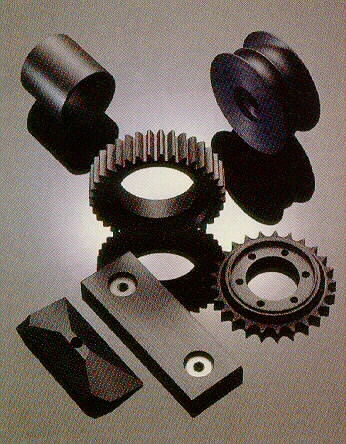|

PROPER DESIGN OF CAST NYLON PARTS
Many distributors have gone beyond the simple buying and selling of stock shapes and are now selling a "value added" product. This means that the distributor is either fabricating in house or working closely with engineering to properly design a finished part. Either way, it is important to know how cast nylon differs from traditional metals.
Many of the cast nylon parts being designed are replacements for metal parts. Steel sheaves and wheels are being replaced by cast nylon, and brass or bronze bushings and wear plates are being replaced (by Licharz' OILAMID). These parts can only perform at their best if they are properly designed. The fabricator or engineer not used to working with cast nylon may not be aware of some significant differences which must be taken into account when designing a new part or converting to cast nylon.
Load capacity - First and foremost, check the load on the part. Some simple engineering and a quick check of the material properties can tell you if the part is capable of carrying the specified load. Remember that higher speeds will decrease the load capacity. If the load is too high, try to increase the load bearing area of the part.
Temperature - What is the ambient and/or working temperature of the part when it is in service? Remember that high loads, high speeds or long duty cycles can raise the working temperature of the part.
Decreased load capacity - The performance of cast nylon decreases considerably as the temperature goes up. Compressive strength at 70øF is 15,950 psi, but only about 12,900 psi at 100øF. You should design for the maximum temperature.
Dimensional changes - Cast nylon will expand at the rate of 0.1% per 10øC increase in temperature. This means that a strip of cast nylon 30.000" long at 70øF will become 30.051" at 100øF. All but one of the mounting holes drilled into such a strip should be slotted to allow the strip to expand and contract. This will eliminate buckling of the strip between mounting holes.
Moisture - Will the part be subjected to high humidity, or be immersed in water? Cast nylon absorbs 7% moisture at saturation. Although it can take years to saturate a thicker part, the top millimeter will absorb moisture very quickly.
Decreased load capacity - Any moisture absorption decreases the load carrying capacity of the portion of the material which has absorbed the moisture. This means that the top millimeter or so of the part will show decreased load capacity compared with the material underneath.
Increased friction coefficient - Absorbed moisture can also increase the friction coefficient of any of the cast nylons. Generally, regular lubrication of the part while in service will counteract this increased friction. An alternative is to periodically mill off the top surface layer.
Dimensional changes - As the material absorbs moisture, it expands at a rate of about 0.18% per 1% absorbed moisture. The amount of expansion from ambient absorption is generally negligible. Any parts which are immersed in water for significant periods of time should be designed with this expansion accounted for. Slotted holes are recommended for longer strips.
Tolerances - The design engineer must realize that the tolerances normally used for metals cannot be held when machining cast nylon. Although the material can be machined to a very tight tolerance, it may not stay within that tolerance over time. For example, if a part is machined to, and measures, within +/-0.0001", it may be completely out of tolerance an hour or a day later due to thermal expansion. Since cast nylon is such a poor thermal conductor, even the heat generated during machining can cause dimensional changes.
As a guide, look at the ISO General Tolerance guide. Normal metalworking tolerances fall in the IT 6 to IT 8 range. For cast nylon, IT 9 through IT 11 should generally be used.
Cost - It is also important to consider fabrication costs when designing a part. Designing for maximum yield can help reduce costs. Licharz supplies rods up to 48" standard length, and plate formats up to 72" x 48" standard.
Although it may seem like a lot to consider when designing a part, much of it can be done fairly quickly once the necessary data has been gathered.
Marc Licharz is President of Licharz, Inc. Licharz has been manufacturing cast nylon for over 20 years. They have rod and plate available from stock, and fabricated parts are available on request.
For more information, contact Marc Licharz, Licharz, Inc., P.O. Box 2036, 12 John Walsh Blvd., Peekskill, NY 10566, 888-695-6662, FAX 914-736-2154.
|